CPV-2c are the most common virulent strains found in various countries including the UK (Goddard and Leisewitz, 2010). To date no agent-specific treatment has proven effective for CPV enteritis, therefore treatment remains symptomatic and supportive (Goddard and Leisewitz, 2010). The survival of acute CPV cases is largely dependent on the intensive treatment given when the puppy is hospitalised. Survival of infected puppies ranges from 9% if left untreated to more than 90% in those treated in tertiary veterinary facilities (Kalli et al, 2010). At the authors' facility survival rates between 80 and 84% have been recorded in consecutive studies during the past decade (Schoeman et al, 2007; Goddard et al, 2008; McClure et al, 2013). Enteral nutrition was shown to be one of the supportive treatments that played a significant role in the clinical improvement of these puppies (Mohr et al, 2003).
Pathogenesis and clinical manifestations of CPV enteritis
In CPV enteritis, infection with parvovirus is acquired by the faecal-oral route of transmission (Goddard and Leisewitz, 2010). By the third to fifth day viraemia is marked, with CPV preferentially targeting tissues with rapid turnover including the intestinal epithelium, lymphoid tissue and bone marrow. Conditions that increase cell turnover, e.g. diet change and change in bacterial flora due to weaning or concurrent endoparasitaemia or corona virus infection, favour viral replication and increase the severity of the resulting lesions and clinical disease. In the intestinal tract, parvovirus replication kills cells of the germinal epithelium of the intestinal crypts, leading to epithelial necrosis, villus atrophy and collapse of the intestinal epithelium and loss of absorptive capacity with a marked decrease in plasma citrulline concentration (Dossin et al, 2011). This clinical syndrome is most commonly seen in pups after weaning and up to 6 months of age (Schoeman et al, 2013), but older dogs may be infected and may become clinically ill. Typical signs include vomiting and a mucoid to haemorrhagic diarrhoea with marked abdominal pain (Goddard and Leisewitz, 2010). The chance of non-survival is higher in parvovirus infected puppies that have evidence of systemic inflammatory response syndrome (SIRS) at the time of admission, and more than half Canine parvovirus (CPV) was first discovered in 1967 and canine parvovirus enteritis first emerged in 1978 as an important cause of severe, often fatal enteritis in dogs (Schoeman et al, 2013). By the end of 1983, it had been reported in 50 countries around the world. It has remained a leading cause of enteritis in dogs despite the wide availability of effective vaccines. CPV-2a, CPV-2b and the new, highly virulent of the puppies with SIRS die (Kalli et al, 2010). The systemic inflammatory response is thought to be due to bacterial translocation from the damaged intestinal tract leading to coliform septicaemia (Prittie, 2004). SIRS deaths were correlated with interleukin-6 (IL-6) levels, and it is postulated that IL-6 may play a role in endocrine perturbations that were found to be associated with death in parvovirus enteritis (Schoeman et al, 2007).
A presumptive diagnosis is made based on the presence of the described clinical signs in unvaccinated puppies (Goddard and Leisewitz, 2010). A diagnostic test that could be used in practice involves detection of CPV in the faeces of affected dogs using a faecal enzyme-linked immunosorbent assay (ELISA) test that is available for in-hospital testing (Goddard and Leisewitz, 2010).
Treatment of CPV enteritis
Most puppies require admission to hospital and aggressive fluid therapy with crystalloids, with or without colloids (Figure 1). Initial treatment usually consists of an intravenous balanced isotonic crystalloid such as lactated Ringer's solution (Goddard and Leisewitz, 2010). Hypoglycaemia and hypokalaemia are common in these patients and need to be corrected and monitored along with fluid replacement therapy (Prittie, 2004). Electrolyte disturbances can vary with severely affected puppies showing hypochloraemic alkalosis and mildly affected puppies being more likely to have hyperchloraemic acidosis (Burchell et al, 2014).
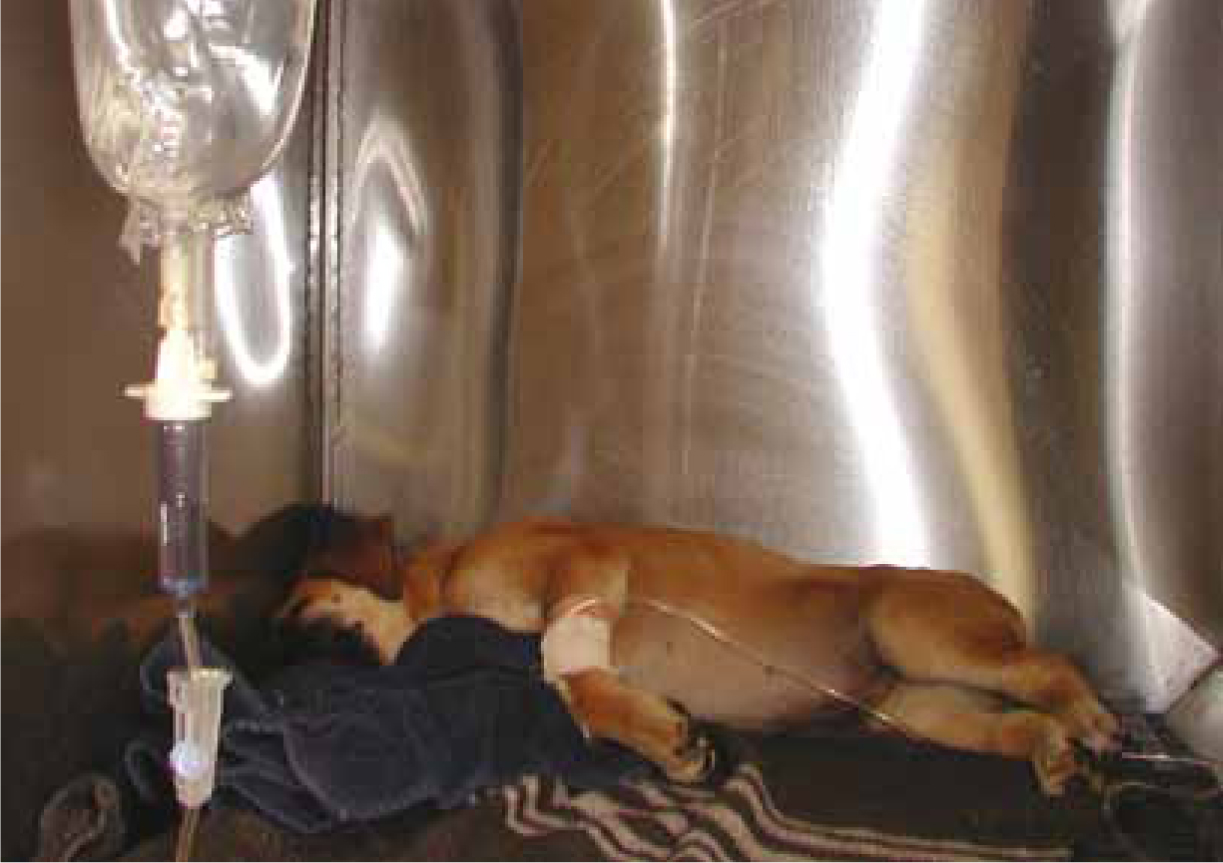
Many puppies have significant decreases in serum total solids and albumin concentrations partly due to intestinal protein loss and malabsorption, and in some cases colloidal fluid support may be required (Prittie, 2004). Various antibiotic recommendations include the use of penicillins, fluoroquinolones and aminoglycosides (Goddard and Leisewitz, 2010). Antiemetic drugs should be used to control the vomiting as these puppies are usually vomiting profusely (Goddard and Leisewitz, 2010). Drugs include metoclopramide, either intermittently or as a constant rate infusion, ondansetron or maropitant in cases with severe vomiting or prochlorperazine once puppies are fully hydrated. Phenbendazole for a period of 5 days is used to eradicate any intestinal helminths (Goddard and Leisewitz, 2010). Opioids such as buprenorphine or constant rate infusion of fentanyl are used to control severe abdominal pain. Once puppies are haemodynamically stable, enteral nutrition is implemented (Goddard and Leisewitz, 2010).
Early enteral nutrition
In canine parvovirus enteritis nil per os for the first 24–72 hours used to be recommended in the past (Goddard and Leisewitz, 2010). However, early enteral nutritional support has been shown to be associated with more rapid clinical improvement (Mohr et al, 2003). Puppies fed via nasoesophageal (NE) feeding tubes from 12 hours after admission showed earlier improvement of clinical signs and had significant weight gain compared to puppies that were not fed until vomiting had stopped. Parameters reflecting improved intestinal barrier function were also observed, suggesting that early enteral nutrition may limit bacterial or endotoxin translocation from the intestines decreasing the potential resultant coliform septicaemia and SIRS (Mohr et al, 2003). Another study in puppies with haemorrhagic gastroenteritis showed that enteral nutrition could result in vomiting shortly after initiation of feeding, but this is probably not significant because tolerance to the food soon developed in these patients (Will et al, 2005). Studies in general hospital populations of critically ill small animals have also shown that nutritional supplementation, even in moderation and providing close to resting energy requirements (RER), was positively associated with discharge from hospital (Brunetto et al, 2010; Liu et al, 2012). The exact timing of early enteral nutrition varies in both human and animal literature (Jacobs et al, 2004). In some experimental animal studies, nutrition was initiated within 2 hours. Some human studies recommend feeding as early as 6 hours and others as late as 72 hours after admission (Jacobs et al, 2004). A more recent veterinary study defined ‘early’ nutrition as nutritional supplementation within 24 hours after admission (Liu et al, 2012).
Feeding methods
Puppies can be fed through force feeding or syringe feeding or alternatively, one of various feeding devices such as nasoenteric-, oesophagostomy-, gastrostomy- or jejunal feeding tubes can be placed (Prittie, 2004). Most puppies with parvovirus enteritis will require less than 10 days of nutritional support, making nasoenteric tubes the best choice in these patients (Marks, 2001). Nasoenteric tubes are either nasogastric (NG) tubes or NE tubes (Figure 2). Apart from being the device of choice for short-term nutrition, these tubes do not require general anaesthesia during placement (Figure 3) (Yu et al, 2013). Because puppies with canine parvovirus enteritis may not be good candidates for general anaesthesia, oesophagostomy, gastrostomy and jejunal tubes are not recommended. The choice of whether to use NE or NG feeding largely depends on the preference of the attending clinician (Figure 4). Previously it was thought that NG feeding tubes were associated with more complications because they would interfere with closure of the lower oesophageal sphincter. These potential complications include regurgitation, aspiration pneumonia, gastroesophageal reflux and reflux esophagitis (Yu et al, 2013) and many clinicians preferred the use of NE tubes. Arguments for NG tube placement include the fact that gastric decompression can be achieved if the end of the tube is situated within the stomach lumen and that gastric residual volumes (GRV) can be measured regularly. A recent study showed that complication rates with nasoenteric tubes were quite low and that complication rates between NG and NE tubes were not significantly different (Yu et al, 2013). Complications that could occur with either of these tubes include epistaxis during tube placement, tracheal intubation, dacrocystitis, rhinitis, aspiration pneumonia, vomiting, regurgitation and blocked or dislodged tubes (Marks, 2001; Yu et al, 2013). Because of the risk of tracheal intubation it is important to verify the correct placement of the tube before securing it (Marks, 2001). The authors prefer making a lateral thoracic radiograph to confirm placement of the tube in the oesophagus (NE) or stomach (NG) (Figure 5).
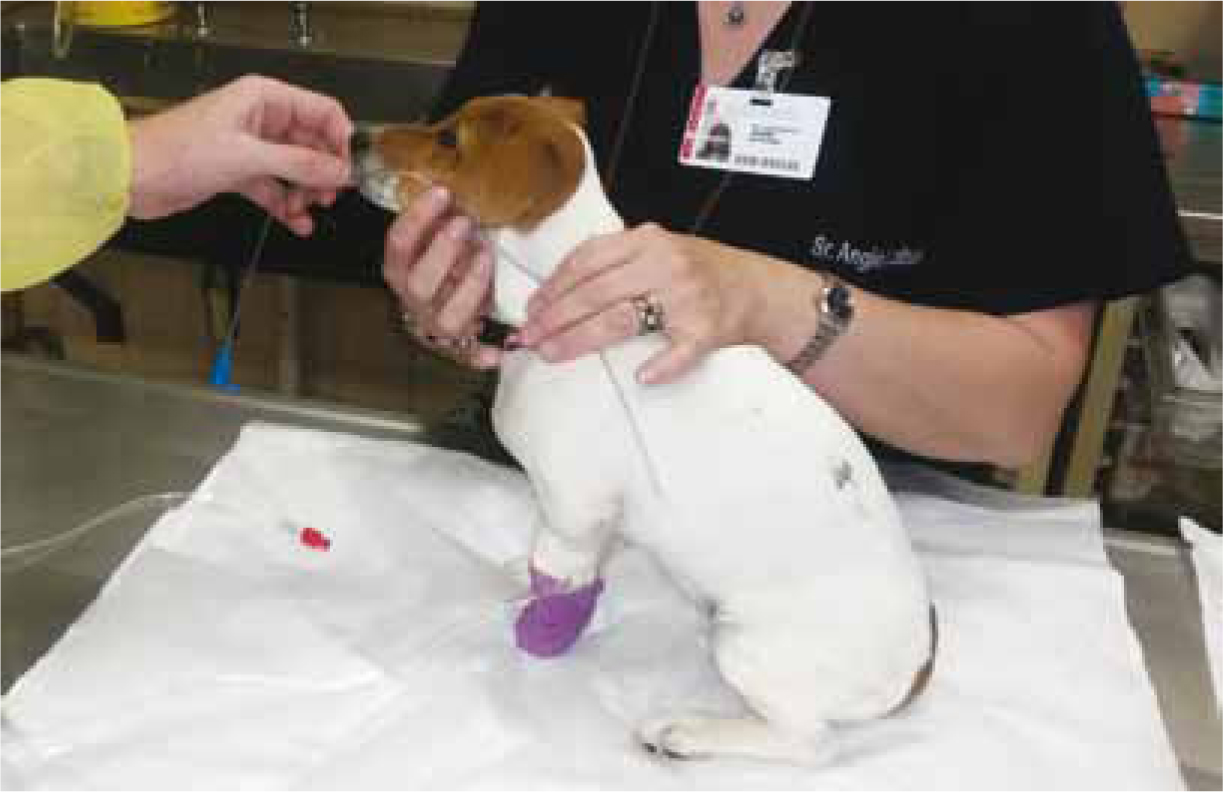
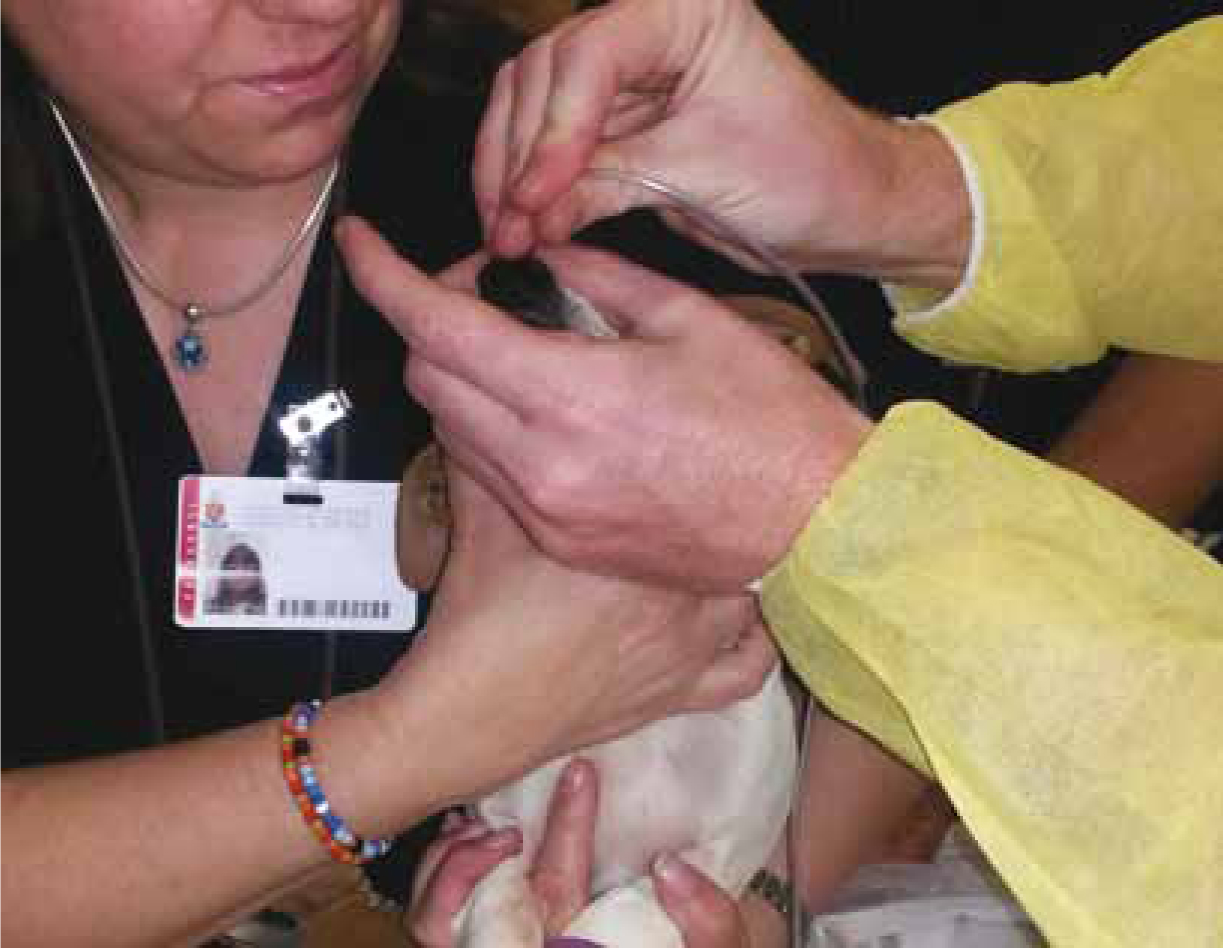
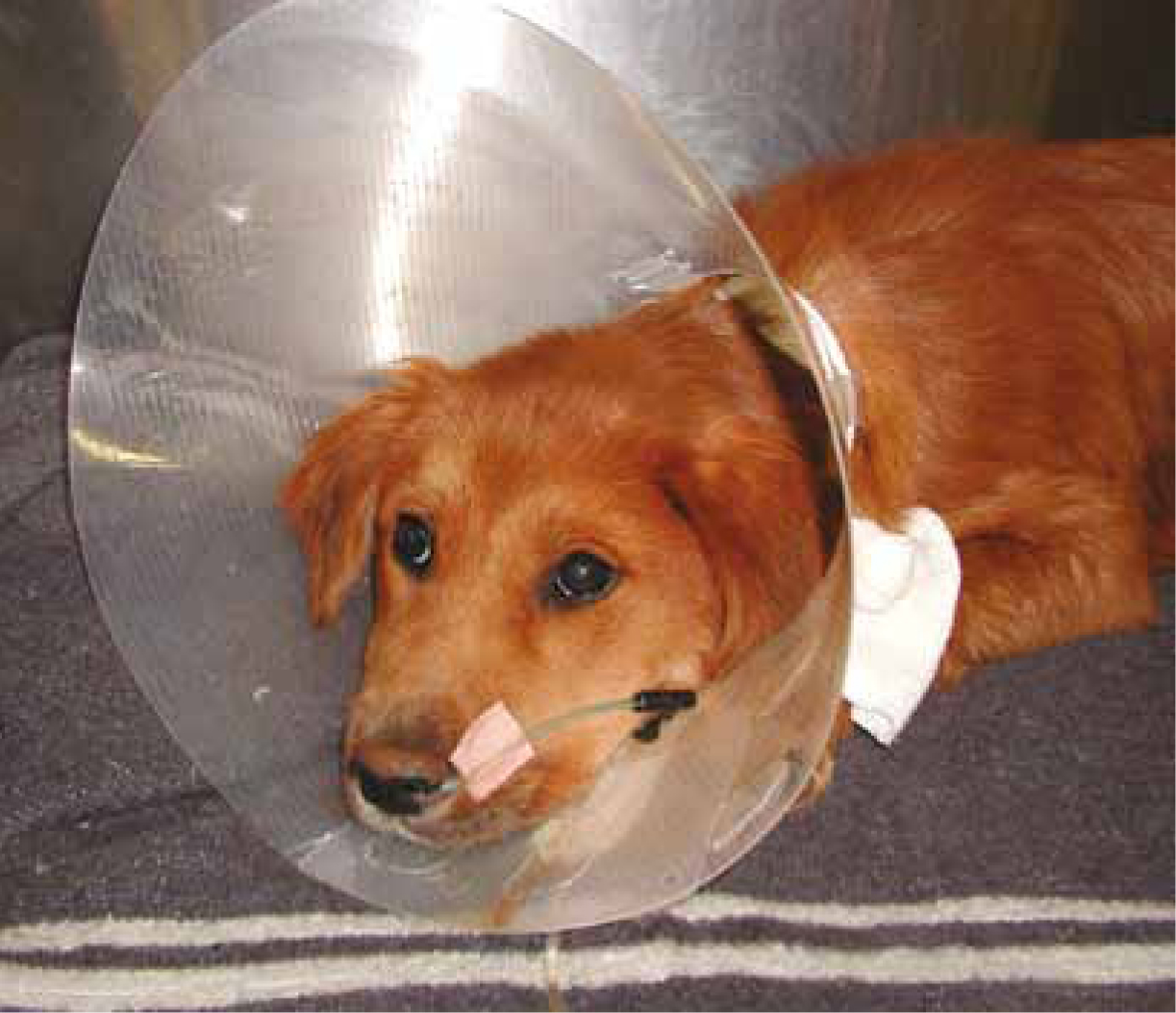
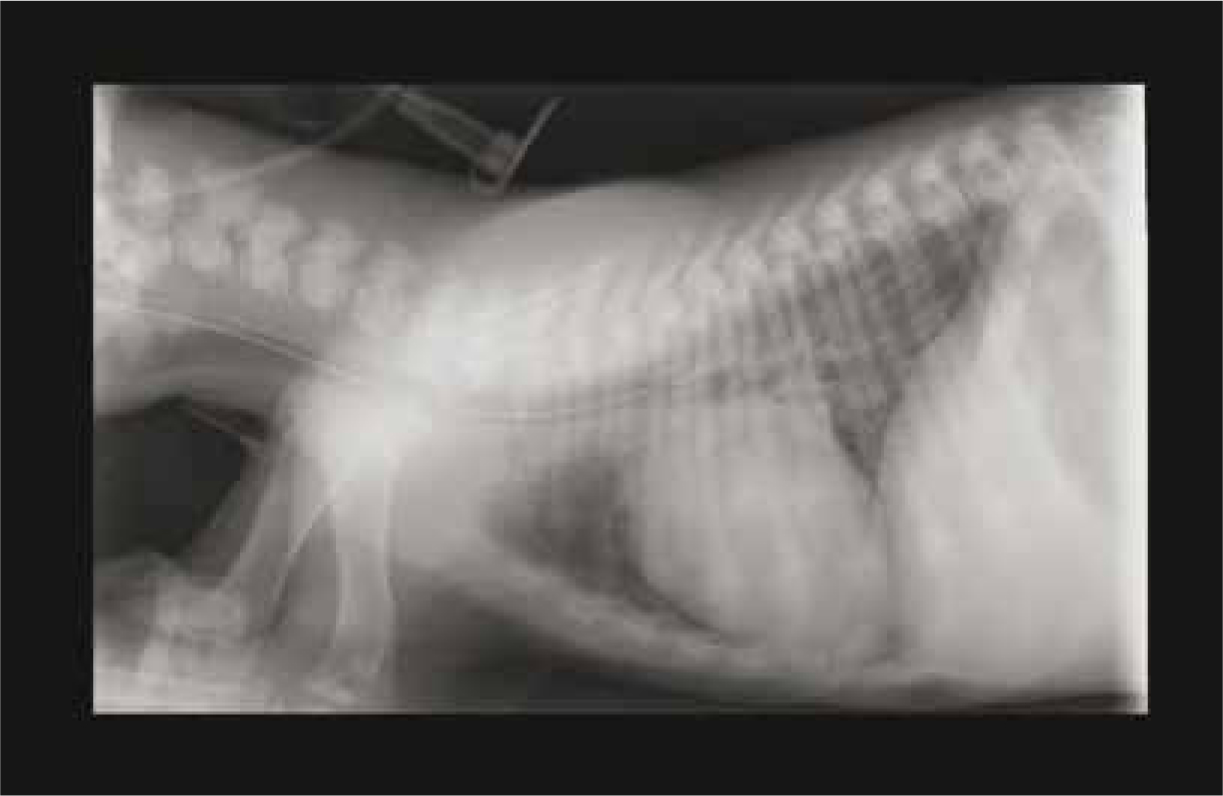
Feeding devices
In human as well as veterinary medicine feeding via enteric tubes can be achieved by either intermittent bolus administration or by constant rate infusion of liquid food. Two veterinary studies published in 2010 investigated the differences between bolus feeding and continuous feeding (Campbell et al, 2010; Holahan et al, 2010). In a retrospective study there was no difference in the percentage of nutrients delivered over 24 hours (Campbell et al, 2010). Although there was a statistically significant difference in percentage nutrients delivered in a prospective study, the authors commented that this difference would probably not be clinically significant (Holahan et al, 2010). They showed that percentage nutrient delivery was slightly less in the continuous infusion group. Both studies showed that there were no statistically significant differences in the rate of gastrointestinal complications such as vomiting, diarrhoea and regurgitation between the two methods. Prospectively there were increased incidences of technical complications in the continuous infusion patients, but there were no differences in the GRV of the two groups (Holahan et al, 2010). GRV were not correlated with the occurrence of vomiting or regurgitation in either of the groups and it was concluded that increased GRV did not necessarily justify discontinuation of enteric feeding (Holahan et al, 2010).
GRV
Many controversies exist around the concept of GRV and its significance in both human and animal critical care patients receiving enteral nutrition (Parrish and McClave, 2008; Epstein, 2014). It was thought that GRV that remained in the stomach for some hours after feeding could potentially result in increased incidence of gastric reflux and aspiration pneumonia in critically ill patients (Parrish and McClave, 2008). For this reason suctioning of GRV became common practice in human and animal medicine (Marks, 2001; Parrish and McClave, 2008). Earlier recommendations in veterinary medicine suggested that GRV should be determined by aspiration via the tube every 8 hours, particularly in patients receiving continuous feeding (Marks, 2001). It was recommended that feeding is discontinued if residual volume exceeds twice the volume of food infused in 1 hour. After 2 hours of rest without enteral nutrition, feeding is reintroduced at 25% less volume than before.
In 2013 a review of six studies examining the use of GRV in human patients revealed that this practice appeared to be unnecessary as an aid in guiding nutrition in ventilated patients (Kuppinger et al, 2013). Based on a single surgical study, the authors suggested that maintaining a low GRV may however be of benefit in human surgical patients (Kuppinger et al, 2013). More recent veterinary recommendations suggest that GRV is checked every 4 hours (Haskins, 2012). Clinical evidence of excessive gastric volume includes a distended abdomen, restlessness after feeding, salivation, retching and vomiting. If more than 50% of the fed volume is aspirated after 4 hours it may indicate that gastric emptying is inadequate (Haskins, 2012). Extrapolations from human literature define absolute gastric volume as 1–4 ml/kg bodyweight and suggest that feeding should be stopped if volumes exceed 8 ml/kg (Haskins, 2012). If the aspirated GRV is not excessive it can be reinstilled, minimising the potential risk of exacerbating electrolyte disturbances by removing electrolyte containing fluid.
Practical application of enteral feeding in puppies with parvovirus enteritis
Based on the evidence as outlined above, the authors make use of either NG or NE feeding tubes at their teaching hospital, depending on the preference of the attending clinician. All patients receive standard supportive care which includes fluid therapy, antibiotic and anthelmintic therapy and a constant rate infusion of metoclopramide as an antiemetic and to promote gastric emptying. Enteral nutrition is initiated as soon as the patients are haemodynamically stable. This usually occurs within the first 12 hours after admission. A highly digestible diet that is easy to tube feed needs to be used. The authors' hospital makes use of Royal Canin Recovery RS™ (Royal Canin Veterinary diets®). Hill's® Prescription Diet® a/d is another commercially available diet that is easy to feed via nasoenteric tubes. Some clinicians prefer to make use of a diet with slightly lower fat content such as Hill's® Prescription Diet® feline i/d. Patients are fed intermittently with the goal of providing resting energy requirements (RER = (bodyweight)0.75 x 70) over a 24 hour period. If severe profuse vomiting was part of the presenting problem, food is slowly introduced initially. Puppies are fed 50% of the RER on the first day of feeding. If this is tolerated well the volume of food is increased by 25% on day two and again on day three to achieve 100% energy supplementation by day three. In patients that show clinical evidence of excessive gastric volume as defined above, GRV is determined and aspirated if deemed necessary. In some cases, and depending on the judgment of the attending clinician, a portion of the suctioned fluid is reinstilled to minimise electrolyte imbalances. Clinical observations at the authors' teaching hospital indicate that most puppies that require gastric emptying only need one-off suctioning of GRV. Feeding is reintroduced after approximately 1 hour of rest, and in some cases feeding volumes are decreased by approximately 25%. The majority of patients will not require repeated GRV suctioning and seem to tolerate subsequent feeding very well. Continuous rate feeding is preferred in patients that do not tolerate intermittent bolus feeding at all. In most cases continuous rate infusions are not set up using infusion pumps, but patients are rather manually fed very small amounts every 30 to 60 minutes. The feeding plan is adjusted according to the needs and tolerance of the particular patient. As soon as patients are able to tolerate tube feeding of RER in 24 hours, bland food such as boiled chicken is offered. Tubes are removed when patients willingly consume close to RER voluntarily.
Conclusion
Enteral feeding of puppies with parvovirus enteritis is beneficial and could decrease length of hospitalisation. The benefits of early enteral feeding in these patients include improved healing of damaged enterocytes, improved absorption of nutrients required for recovery from illness and decreased bacterial translocation which could prevent the development of systemic inflammation and sepsis. Early enteral feeding is implemented within 12 hours after admission to hospital and haemodynamic stabilisation with fluid therapy and supportive antibiotics and antiemetics. Clinicians and veterinary nurses need to consider the facts when implementing a nutritional plan in these small patients and feeding protocols are adjusted based on the response of the individual patient.

